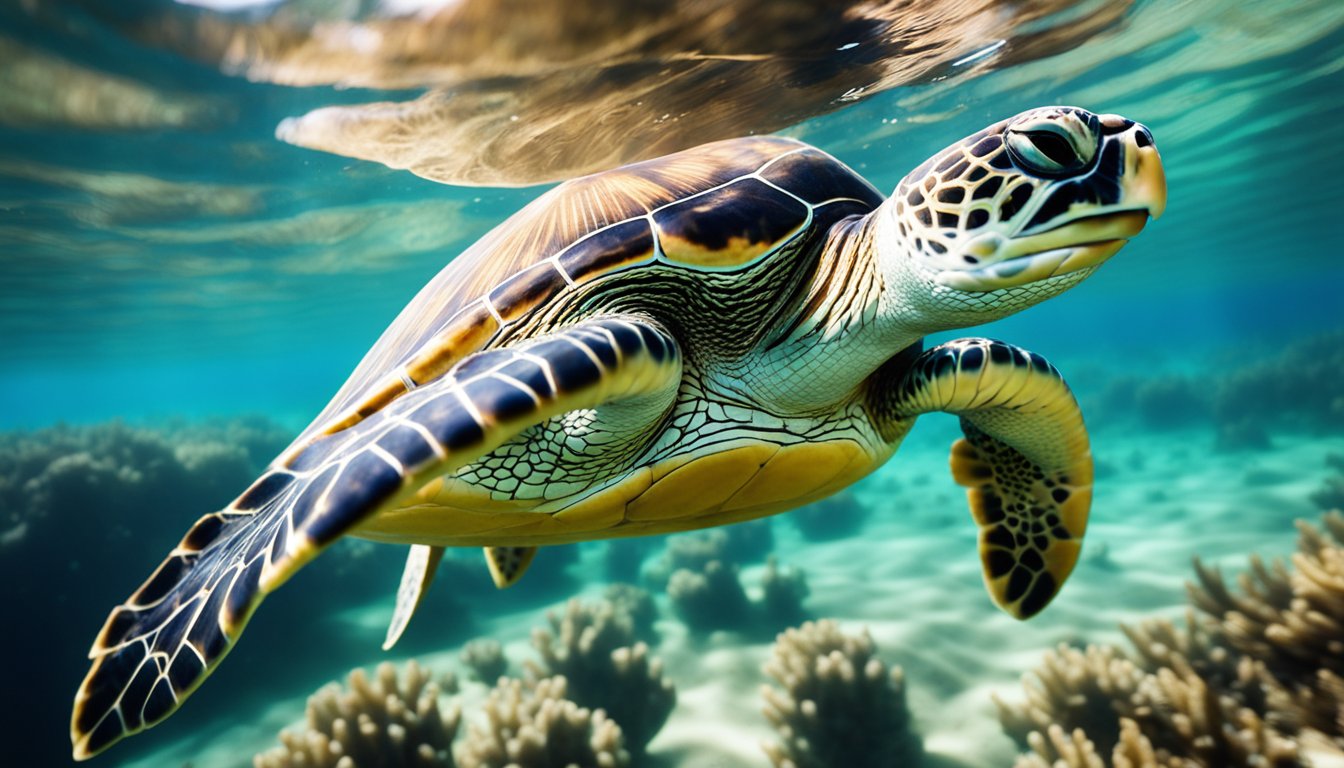Imagine embarking on an epic journey across the vast, swirling waters of the ocean without any modern technology for guidance.
This is the incredible adventure sea turtles undertake every year.
These remarkable creatures traverse thousands of miles through the big blue sea with astounding precision.
But have you ever wondered how sea turtles navigate their way through the expansive ocean?
They can’t use a compass or a map, yet they manage to find their way with remarkable accuracy.

Sea turtles have an inner compass that guides them, and they use the Earth’s magnetic field much like sailors once used the stars.
The ocean is their highway, and they have special ways of reading nature’s signs to know where they’re going.
They can sense the angle and intensity of Earth’s magnetic field, which helps them determine their latitude and longitude, ensuring they stay on course.
Each beach has its own magnetic signature, and it’s believed that turtles remember these signatures to return to the same spot where they were born to lay their eggs.
It’s also thought that when they first enter the sea as hatchlings, sea turtles rely on the direction of the waves to orient themselves.
This initial path-setting is crucial, and once out in the ocean, they’re able to navigate using a combination of sun positioning during the day and wave directions at night.
The vast ocean becomes a little less daunting when you have the skills to read its natural clues.
As science continues to uncover the secrets of sea turtle navigation, we get a glimpse into the intricate and fascinating ways these animals interact with their environment.
The Mysteries of Sea Turtle Migration
Sea turtles are incredible navigators, traveling thousands of miles to reach their nesting grounds.
But how do they find their way through the vast ocean?
Let’s dive into the captivating journey of sea turtle migration and uncover the secrets of their voyages.
Understanding Migration Patterns
Many sea turtle species embark on long-distance migrations, often traversing entire oceans to feed and breed.
Researchers use satellite telemetry to track the paths of sea turtles, revealing incredible journeys that connect feeding grounds to nesting beaches.
Some species, like the leatherback sea turtle, may migrate over 10,000 miles in a single trip.
It’s a testament to their endurance and navigational skills.
The reason behind these migrations often ties to finding the best environments for feeding and reproducing, ensuring the survival of their species.
By understanding these patterns, conservationists can better protect these endangered creatures and their complex life cycles.
The Marvel of Hatchling Journeys
From the moment they emerge from their eggs on the natal beach, hatchlings have a big challenge ahead.
They must reach the ocean and navigate to safe waters away from predators.
Initially, hatchlings use the moonlight reflecting on the water and the slope of the beach for orientation.
They have an innate sense to head towards the brightest horizon, which is typically seaward.
It’s a perilous time, as hatchlings are vulnerable to numerous threats, including natural predators and human-made obstacles.
Perils Along the Voyage
The ocean is full of wonders and dangers, especially for sea turtles on the move.
They face natural predators, such as sharks, and human threats, like fishing nets and plastic pollution.
The survival of each species depends on safe passage through these treacherous waters.
Conservation efforts strive to safeguard sea turtle migration routes and nesting grounds.
Protective measures include beach patrols, marine protected areas, and reduction of bycatch in fisheries.
By understanding the challenges sea turtles face, people can take action to ensure these ancient mariners continue to grace our oceans for generations to come.
Navigational Tools of the Sea Turtle

Sea turtles are nature’s navigators, crossing vast oceanic expanses with remarkable accuracy.
They employ a blend of natural tools that many scientists find quite fascinating.
The Role of Magnetic Fields
Imagine having a built-in compass in your brain that helps you find your way; that’s what sea turtles have!
They can detect the Earth’s magnetic field and use it as a guide.
Their brains interpret magnetic cues to discern north, south, east, and west, just like a hiker would with a handheld compass.
But it’s not just any compass; it’s a magnetic compass that’s finely tuned to the magnetic features of the ocean, making these shelled adventurers genuine experts in magnetic navigation.
Sun, Stars, and Currents: Nature’s Compass
Besides magnetic clues, sea turtles also get help from the sky.
They use the position of the sun during the day, much like ancient mariners did.
By night, the stars take over as twinkling guides, though scientists are still sorting out just how turtles perceive the constellations.
Even the waves have a part to play.
Ocean currents carry whispers of direction, supporting turtles’ orientation as they ride the rhythmic paths paved by the undulating sea.
Innate Instincts and Learned Behaviors
From the moment they burst from their eggs, sea turtles are on the move.
Hatchlings have an innate sense to head towards the water, with some researchers suggesting moonlight on the water may help guide them.
As they grow, they learn to interpret various cues, like the pitch and roll of the inner ear sensation associated with waves and much more.
The leatherback turtle, one of the largest and most migratory, is especially adept at using a mix of these impressive abilities to navigate through open waters, showcasing a profound connection with their marine world.
The Science Behind Sea Turtle Navigation

Sea turtles, ancient mariners of the oceans, possess a remarkable ability to navigate long distances.
This intricate skill is a focus of fascination for marine biologists and researchers, who endeavor to unlock the secrets of their migration paths and the incredible internal compass sea turtles seem to carry.
Unlocking the Secrets Through Research
Scientists have long been intrigued by the way that sea turtles can traverse oceanic expanses, finding their way back to the beaches where they were born or pinpointing remote feeding grounds.
Studies show that loggerhead sea turtles, for example, might be using the Earth’s magnetic field as a map, sensing different magnetic imprints along their journey to guide them.
By closely observing and tracking sea turtle habits, researchers are gaining insights into how these animals operate within their changing marine habitats and how they may be influenced by factors like climate change.
Technological Advancements in Tracking
Technological progress has been pivotal in advancing our understanding of sea turtle navigation.
Satellite tracking has become an invaluable tool in the field of marine biology, helping to chart the courses of sea turtles over vast distances.
The detailed information gathered from these devices is helping to map their routes more accurately than ever before, revealing patterns that were once hidden beneath the waves.
This data not only enhances our knowledge of sea turtle behavior but also contributes to conservation efforts, aiding scientists in protecting these creatures and their environments from the impact of climate change and other threats.
Frequently Asked Questions

Sea turtles embark on incredible journeys across the ocean, using remarkable navigation skills that scientists are still working to understand fully.
These creatures possess an innate ability to find their way across vast and open waters with surprising accuracy.
Why do sea turtles migrate such great distances?
Sea turtles migrate long distances mainly for feeding and breeding purposes.
They travel to specific beaches to lay their eggs, ensuring the survival of their species.
The warm sands of these beaches are crucial for the incubation of their eggs.
What cues do sea turtles follow to navigate the ocean?
Sea turtles use a variety of cues to navigate the ocean, including the sun, stars, and wave patterns.
Research suggests these reptiles may also detect the earth’s magnetic field, which helps them in long-distance navigation.
How do baby turtles find the ocean after they hatch?
After hatching, baby turtles find the ocean by moving away from the darkest silhouette of the landward horizon and towards the brighter, open horizon over the ocean.
They are also guided by the slope of the beach and the sound of the waves.
In what ways do sea turtles use the Earth’s magnetic field to find their way?
Sea turtles are thought to use the Earth’s magnetic field like a compass, which allows them to determine their position and direction in the ocean.
Some scientists believe that they can detect both the angle and intensity of the magnetic field to assist them in their navigation.
Can sea turtles remember their birthplace?
Yes, they can. Adult sea turtles return to the same nesting beaches where they were born to lay their eggs.
This remarkable homing behavior suggests that they can remember their birthplace even after several years and miles of travel.
How do changes in the ocean environment affect sea turtle navigation?
Changes in the ocean environment, such as temperature rises, ocean acidification, and magnetic disturbances, can disrupt the cues sea turtles use to navigate.
These disturbances could potentially lead to disorienting turtles and affecting their ability to find nesting grounds or feeding areas.









